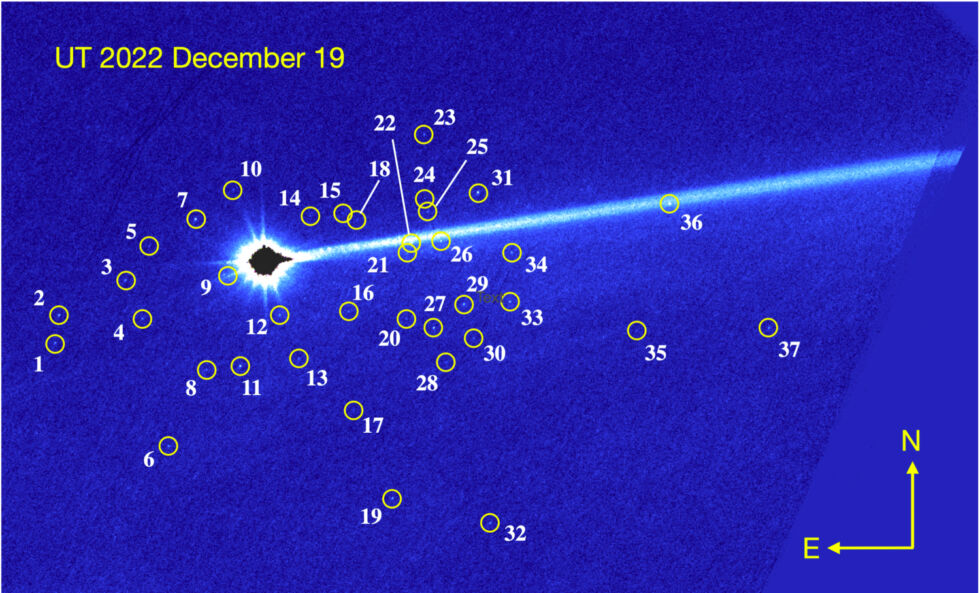NASA’s Double Asteroid Redirect Test (DART) mission was a success from the perspective of planetary defense, as it successfully shifted the orbit of an asteroid. But the mission had a scientific element to it, and we’re still sifting through the debris of the collision to determine what the impact tells us about the asteroid. That’s difficult due to the distance to the asteroid and the low amounts of light that reflect off the debris.
Today, a paper was released by a team that analyzed images of the aftermath using the Hubble Space Telescope. They’ve spotted dozens of boulders that collectively would have originally made up 0.1 percent of the mass of Dimorphos, DART’s target. And while they’re all moving very slowly from the site of the collision, some of them should be able to escape the gravity of the double asteroid system.
Knocking rocks
The images taken by DART immediately prior to its demise suggest that Dimorphos was a rubble pile, a mixture of boulders, small rocks, and dust barely held together by their mutual gravitational pull. So what happens when a relatively solid object, like the DART spacecraft, hammers an asteroid at high speed?
For a while, the answer was “a lot of dust.” Early images show lots of material pouring out from the asteroids, spreading out in space and forming a long “tail” driven away by the radiation pressure of the Sun. But, with time, the debris cleared up enough that Hubble was able to get a clear picture of any larger objects that had been obscured by the dust—or rather, a number of clear pictures.
The challenge with this is that those larger objects would still be quite small and reflect very little in the way of sunlight. As a result, they’d generally appear as small points of light and appear indistinguishable from cosmic rays striking the detector or background stars that moved through Hubble’s field of view during imaging.

So, the Hubble images had to be long-exposure to capture enough light, and the researchers combined multiple exposures taken by Hubble at different points in its orbit around Earth (which required them to reorient the image so that they all showed the equivalent area from the same angle). Light that only showed up in one or a few of the images was discarded, getting rid of some of the noise.
Once the exposures were combined, the researchers could identify roughly 40 objects that were moving along with the Didymos/Dimorphos system but distinct from it. Only the brightest of these are visible in the individual images.
Small and slow-moving
Based on the amount of light they reflect, the researchers estimate that the boulders they’re seeing are in the range of 4–7 meters across. This is based on the average reflectivity of the parent asteroids; obviously, any darker or brighter boulders will throw these estimates off. The researchers also use a single-density estimate based on the intact asteroids to figure out the boulders’ likely masses. Collectively, they’re estimated to carry about 0.1 percent of the pre-collision mass of Dimorphos.
Based on their distance from the impact site, it was possible to estimate their speeds. And they’re all very slow. Even the fastest boulders are moving at less than a meter per second, which translates to taking roughly four hours to travel a kilometer from the impact site. And the slower ones are only a fraction of that speed.
But, given the incredibly weak gravity of the double asteroid system they came from, the higher-speed objects will be able to escape the gravitational pull. In fact, the boulder population can be roughly divided in half, with the faster half having achieved escape velocity.
The combination of mass and speed let the authors estimate the total kinetic energy carried away from the collision by these rocks. Compared to the energy delivered by DART, it’s quite small, at about 0.003 percent of the energy that DART delivered.
Since Dimorphos is a rubble pile, there’s no reason to think that these are the product of DART shattering a larger rock on impact. Instead, Dimorphos was built from rocks that were pre-shattered by collisions in the distant past; DART just liberated a few of them from the rubble pile’s gravity. Based on the pre-impact images of Dimorphos, the researchers estimate that the boulders would have collectively occupied about 2 percent of the asteroid’s surface. That’s consistent with DART having blasted out a crater about 50 meters across.
The crater could potentially be smaller if DART had imparted enough seismic energy to knock material loose from elsewhere on the asteroid. But, given that rubble piles are expected to be very porous, it’s unlikely that seismic energy gets very far in its interior.
In any case, we’ll have a clearer picture of things once the European Space Agency’s HERA probe reaches the asteroid for a follow-on study. Just have to be patient, as that’s not expected to happen for another three years.
The Astrophysical Journal Letters, 2023. DOI: 10.3847/2041-8213/ace1ec (About DOIs).

